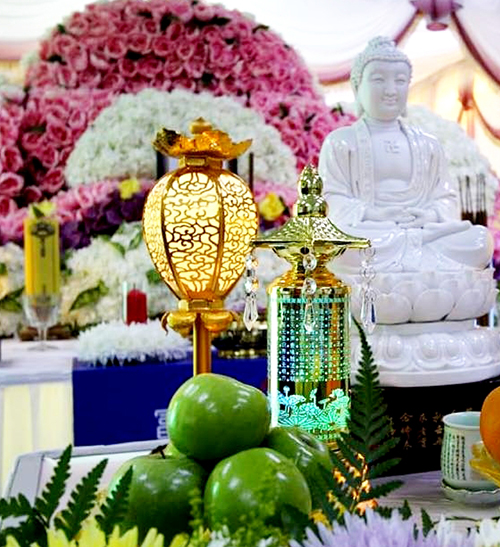
A Step-By-Step Explanation of a Proper Buddhist Funeral
Singapore is a land of many religions with Christian, Muslim, Parsi, and Sikh populations, whereas most of the population belongs to Buddhism.
Each of these religions has a distinct belief system when it comes to death, but Buddhism has a unique concept that is of particular significance to the last rites of a Buddhist.
These concepts are called “samsara” and “karma.”
Buddhist Belief System:
According to the Buddhist belief system, when a Buddhist dies, it is not the end of his life but a beginning of a new chapter of his life. The concept is called “samsara” in Buddhism and is commonly known as reincarnation.
According to this concept, when a Buddhist dies, he gets rebirth in some form or the other. The samsara can either be immediately after death or after a transitional time.
The concept of samsara also includes the concept of “karma,” which is simply the law of cause and effect. Karma means that the deeds you will do will have their consequences in the future, and according to Buddhism, karma will decide how you will wake up in the next life.
The concepts of samsara and karma define how a Buddhist funeral Singapore is performed by a funeral service Singapore.
Types of Buddhist Funerals:
Though all the Buddhists believe in samsara and karma, there are little variations on when the rebirth will occur. These variations define how the funeral will be performed, laying the basis for Buddhism’s three different types of funerals.
Following are those three types:
- Mahayana:
According to the Mahayana belief system, there is a certain transitional period before the dead gets a rebirth. They believe this transitional period is vital as it will decide the merits of the rebirth. Hence, the funeral services are focused on providing a smooth transition to the deceased.
Mahayana supports the transitional period through setup rituals that include the monks chanting Amitabha sutra.
- Theravada:
According to the Theravada belief system, rebirth is immediately after death and no transitional period. They believe that the conditions of reincarnation will depend upon the deeds the deceased did when he was alive or based on karma.
The last rites are still vital and include the monks chanting Abidhamma Sutra, which is the Theravada religious scripture. The ceremony also includes offering a “forsaken robe” to the monks on behalf of the deceased.
The cloth represents shrouds that the monks used as robes in the period of Gautama Buddha, the founder of the Buddhist religion.
- Vajrayana:
The Vajrayana funeral services are aimed at guiding the deceased and freeing him from the Samsara cycle.
The ceremony includes a reading of Vajrayana religious scripture, the Tibetan Book of the Death called the Bardo Thodol, along with some prayers, chants, and the name of Buddha.
Steps of Buddhist Funeral:
Regardless of the belief system, a typical Buddhist funeral includes the following steps:
- Preparation of the Body:
According to the Buddhist belief system, the soul does not leave the body immediately after death occurs, so they leave the body untouched and undisturbed for sometime.
After that, the funeral starts with the body’s preparation for his next journey after he passes away. The preparation includes thorough washing of the body and dressing it in a clean white cloth.
- The Final Viewing:
Once the body has been prepared, it is time to take a final look at the deceased. The body is put in the casket through which one can see the face. The casket is placed in a respectful position, and everybody takes turns to have one last look at the deceased.
This step is important for two reasons. First, it serves a purpose of closure for the closed family members and as a reminder that death is inevitable for the rest of the participants.
- Attires:
At a Buddhist funeral, attendants or participants follow a religious dress code. According to the dress code, the attendance should wear plain white clothesto look the same.
The purpose of the dress code is to ensure that nobody is drawing attention towards them and there is no display of wealth or anything that might disrupt the unity.
- The Wake:
The wake is a ceremony held after the funeral, usually in the first seven days of the death, and is only held on odd numbers like three or five.
The family members, monks, and other people get together at an altar set up for the ceremony in the wake.
A picture of Buddha is placed at the front of the altar, and a portrait of the deceased is displayed in the ceremony. The attendants bring flowers, fruits, and candles while the family, relatives, and the monks chant prayers.
- Burying or Cremation:
The Buddhist funeral concludes with burying or cremation of the deceased as Buddhismallows both.
Since 2007, there has been a hiking trend of cremation at Buddhist funerals as Singaporean authorities have set a definite period of 15 years for burial, afterwhich the remains will be removed from the burial ground and will either have to be shifted to a new burial ground oreventually be cremated.
After cremation, the ashes can either be scattered for green or sea burial or stored in a columbarium after buying a niche.
How To Conduct Buddhist Funeral Properly?
The most suitable way to conduct a proper Buddhist funeral Singapore is to hire professionals for funeral service Singapore as they are not only capable of handling all the funeral-related matters efficiently, they also make sure that each step of the funeral is properly followed as per the guidance of the religion, the belief system and preferences of the deceased and his family.1.
 中文
中文
